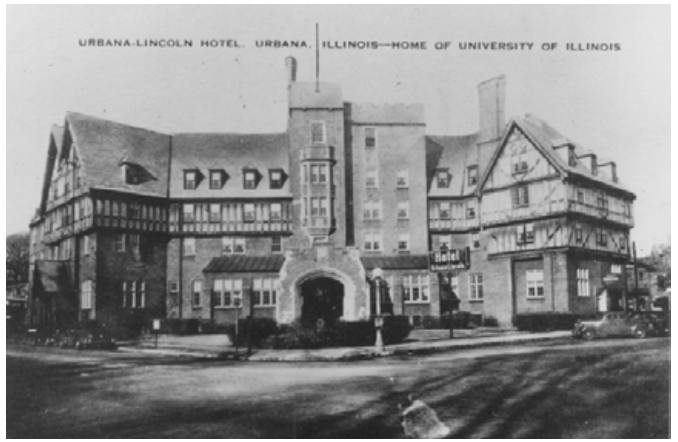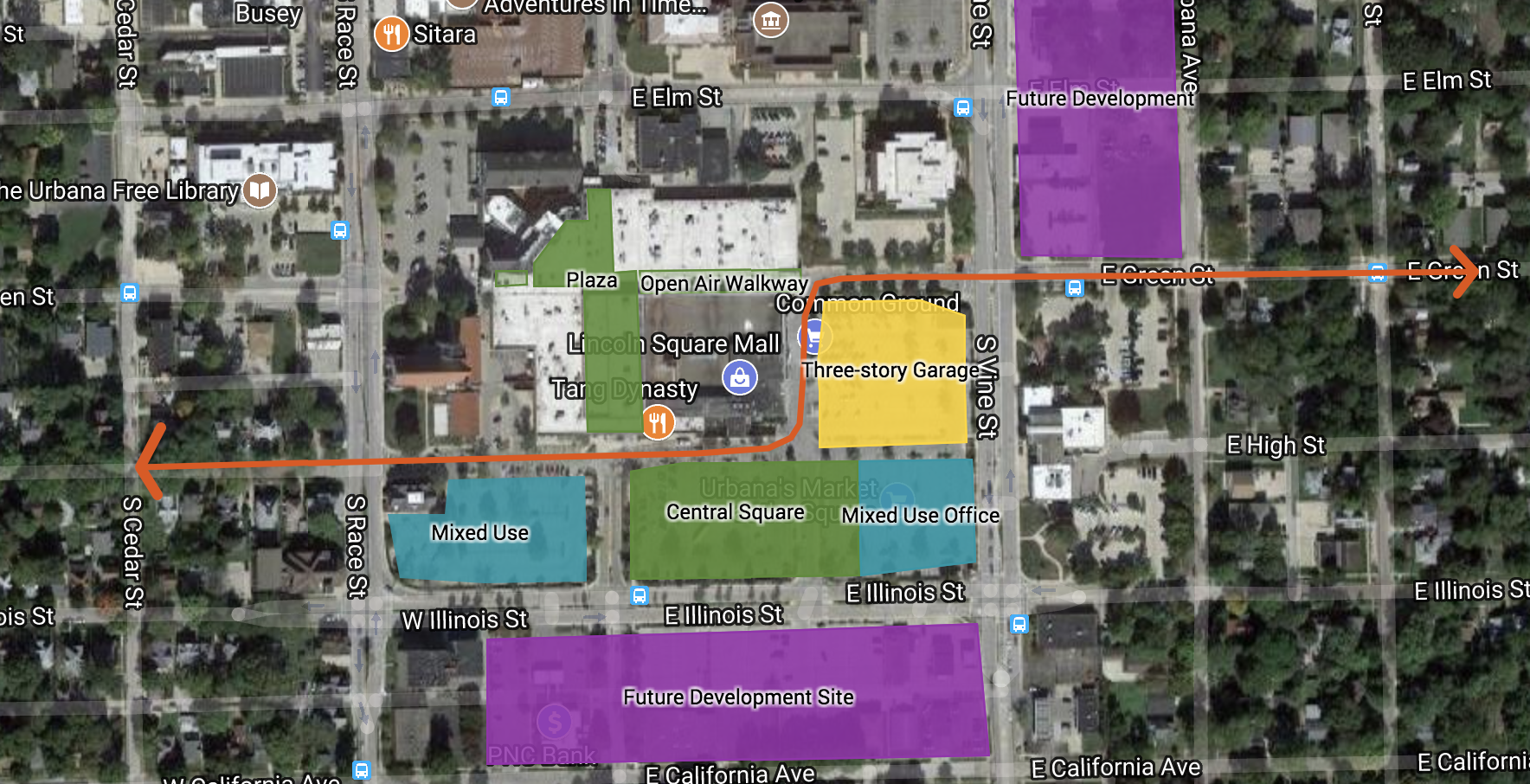Last week I wrote about the troubled history of Lincoln Square Mall, its current status, and the challenges for its, and downtown Urbana’s, redevelopment. Other cities with dead malls have moved government offices or community colleges into their shopping centers, but with Urbana’s City Hall nearby and no recent calling for a Parkland outpost, what should be done here? We can’t tear it down, it’s a landmark. It’s rapidly losing tenants. All its redevelopment plans have been shelved. The only way for the oldest surviving enclosed mall in Illinois to move forward is to reconsider the space surrounding it.
As downtown Urbana sees a wave of investment, from new shops to the Broadway Food Hall, Lincoln Square’s location may be its greatest ally in its redevelopment. The mall may never regain its regional status as it did in the 1960’s, but it could become something more suitable for a downtown. But we need to be imaginative. Lincoln Square is not a normal mall, one can tell that by looking at the hours of operation (5 a.m.- 11 p.m. on weekdays compared to Market Place’s 10 a.m.-9 p.m. window of business hours); it’s a mall in a downtown of a unique city and should function as such. It shouldn’t attempt to be a carbon copy of a themed mall plopped at an urban fringe. It has strong transit connections, a tightly-woven community around it, and regular events from farmer’s markets to music festivals.
Lincoln Square Mall’s nine square block footprint takes up a huge portion of Downtown Urbana, and its expansive parking lot keeps it isolated from the happenings of the community around it. Reintegrating the center into the urban fabric is key. Reintroducing a street grid through its parking lot would organically bridge the spatial gap between residential neighborhood and downtown.
What would that look like? Great question. Urbana’s Downtown Plan (2012) suggests the city would like to improve connections between the farmer’s market and Main Street. Nothing much aside from adding retail to the first floor of the parking structure to the south and expanding the market has been mentioned in the plans. The original 2002 Downtown Plan shows an envisioned redesign of the mall’s facade, into a somewhat colonial building with pillars. These proposals have largely been scrapped.

But I have some ideas. What if Lincoln Square became Urbana’s answer to Taylor Street? Open, bright, filled with art, and public. Hear me out. Lincoln Mall is already open for far longer than a standard mall, and this intervention would help the City of Urbana accomplish its goals of connectivity. “Lifestyle centers” are more attractive to shoppers and potential retailers than enclosed shopping centers and have been shown to perform better than traditional malls in sales. The mall could retain some of its original roof beams that cross over the walkways perpendicularly to create a unique pedestrian experience, possibly incorporating lighting or hanging plants while preserving the architectural style of Victor Gruen. The atrium at the south entrance could feature fountains and public art, Tang Dynasty could even add some outdoor dining space. With Piato moving, the north entrance space could become an open air plaza with a reconstructed southeast entrance (a stately entrance compromised with the construction of the mall) of the Landmark Hotel serving as the focal point. Green walls could help beautify the exterior of the structure where there are no storefronts.
As for the parking lot and the south side of the mall, parking could be consolidated into a garage possibly built in on the lot in between Common Ground and Urbana City Hall so that the rest of the lot could be opened up. The portions of High, Green, and Broadway that extend into the current lot could be rebuilt with street parking and wide sidewalks. Illinois Street directly south of the complex could be narrowed from four to two lanes for much of its stretch to make space for parking, wider sidewalks, and bike lanes. The open spaces on the southwest and southeast corners could become shops, apartments, and offices. A mix of uses, especially residential, is key for a downtown to remain a destination for longer than just the 9-to-5 workday. And to serve as downtown’s southern gateway, the lot directly south of the mall can become open space, an actual square with storefronts surrounding it to host the Market at the Square, concerts, and anyone who just feels like hanging out in downtown Urbana. Maybe the square could encourage some more development on the underutilized lot along the south side of Illinois and east side of Vine.
Of course, this is just a thought. Studying urban planning causes me to think (or dream) about these things. This is a huge undertaking and would require a dedicated developer and investment from the city for new infrastructure. I don’t know what type of tenants a new Lincoln Square could attract, I would hope there would be a mix of restaurants and retail, something you would find on a downtown street, not in a sterile shopping center. Art galleries, creative spaces, restaurants, clothing stores, everyday services, coffee shops, and bars are all fair game.
Admittedly, this is ambitious. It may not be feasible today or tomorrow. It needs all the retail, residential, public space, and commercial features to succeed; the mix is always necessary. Will it ever be feasible? I encourage you to consider these factors:
People are investing in downtown. At the moment there is $7 million of private investment in the area in the form of construction and renovation projects, from Busey Bank to Broadway Market.
There will be potential demand for housing in the area. It is next door to the area’s second largest transit hub. With the completion of MCORE, there could be significant demand for graduate student housing near the transit center, especially given the amenities in downtown and local desire to preserve the familial character of West Urbana.
There is interest in the Landmark Hotel. It was announced earlier this year that Hilton expressed interest in redeveloping the historic hotel, bringing possible support for any redevelopment of the mall.

A downtown is important. It’s the centerpiece of most every city. Does a city need its downtown? Does a TV show need its lead role?
This is, again, just a thought, but if downtown Urbana can continue riding this wave of renewed investment interest, maybe a new Lincoln Square (whatever it may look like) is closer than we think. Urbana owes it to itself.
Included: My proposal for an outdoor Lincoln Square (Own work, Google MyMaps), Proposed facade for the south entrance (2002 Urbana Downtown Plan), Former southeast entrance to the Landmark Hotel (City of Urbana image)








